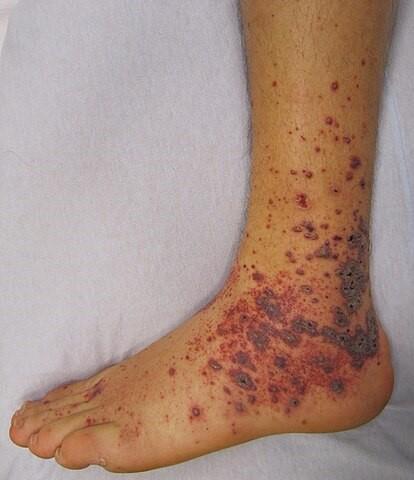Skin rashes
Peer reviewed by Dr Colin Tidy, MRCGPLast updated by Dr Hayley Willacy, FRCGP Last updated 14 Feb 2024
Meets Patient’s editorial guidelines
- DownloadDownload
- Share
There are many different types of skin rashes and many different causes of skin rashes. Although most skin rashes are harmless, some do need treatment (which may be tablets, creams or ointments) from your doctor or pharmacist.
Some rashes (especially dark red or purple rashes that don't fade when you press them) may even need urgent medical treatment as they can be associated with meningitis and blood infection (septicaemia).
In this article:
This leaflet is a guide but if you have any concerns, you must seek urgent clinical assessment if:
The rash doesn't quickly disappear.
You feel unwell.
The rash does not fade with pressure (the best way to test this is to press a glass gently against the rash to see if it fades).
Continue reading below
How are skin rashes described?
Skin rashes can be described in the following way:
Redness of the skin (called erythema).
Flat abnormally coloured areas of skin (called macules). Macules are often either red, dark red or purple, brown or white.
Solid raised areas which are up to half a centimetre across (called papules).
Solid raised areas which are more than half a centimetre across (called nodules).
Areas of red raised skin (called plaques) and scales, which have a flaky silvery-white appearance.
Reddish-purple lesions which do not fade with pressure (called purpura):
If less than one centimetre across then these are called petechiae.
If more than one centimetre across then they are called ecchymoses.
Blisters: these are swellings of the skin containing fluid:
If a blister is less than half a centimetre across then it is called a vesicle. If filled with yellow fluid (pus) then it is called a pustule.
If a blister is larger than half a centimetre across it is called a bulla (plural is bullae).
Patient picks for Skin rashes

Skin, nail and hair health
Rosacea treatments: which is right for you?
Living with rosacea can be difficult. It can be a great source of stress and really impact your quality of life when you have to deal with any facial skin problems. Sadly, 10% of the population experience this skin condition, but the good news is that there are many treatment options. The right one for you will depend on which symptoms you have.
by Amberley Davis

Skin, nail and hair health
Heat rash and prickly heat
Heat rash is one of the most common types of the skin rash, and it's also known as miliaria, prickly heat, or a sweat rash. Heat rash occurs in some people when they sweat a lot. It can be very itchy. It is due to a blockage of the sweat ducts which causes sweat to seep into the skin cells. The main treatment is to keep cool as much as possible.
by Dr Rosalyn Adleman, MRCGP
What skin conditions cause itching?
Skin disorders that can cause itching include (please click the links to separate leaflets which provide further information):
Dry skin.
Continue reading below
What causes skin rashes?
Please click the links to separate leaflets which provide further information:
Red (erythema) but not scaly skin rash
A skin infection called cellulitis.
An allergic reaction called urticaria.
Reaction to a medicine you are taking.
Viral rashes - eg, measles or rubella (German measles).
Vasculitis. This is a condition involving inflammation of blood vessels, which may occur with various illnesses, including rheumatoid arthritis.
Erythema nodosum. This is a condition which causes red rounded lumps (nodules), most commonly on the shins.
Redness on the palms of your hands may be caused by liver disease, pregnancy or an overactive thyroid gland (hyperthyroidism).
A red rash may occasionally be due to an inflammatory condition called systemic lupus erythematosus, especially if it is on the cheeks.
Red (erythema) and scaly skin rash
Psoriasis. This is a condition where there is inflammation of the skin.
Eczema. This is sometimes called dermatitis and also involves inflammation of the skin. It may be caused by an allergy and is then called atopic dermatitis/eczema. This may happen in response to some plants - eg, poison oak or ivy.
Seborrhoeic dermatitis (in adults). This is a type of skin rash sometimes called seborrhoeic eczema. In babies it is known as cradle cap.
Fungal (or 'yeast') skin infection, such as athlete's foot, groin infection (tinea cruris), ringworm, scalp ringworm or infection with candida.
Pityriasis rosea. This condition is described as 'self-limiting' and the rash will clear itself naturally.
Pityriasis versicolor. This is a rash which is caused by a yeast-like germ.
Lichen planus. This condition mainly affects the skin and causes an itchy rash.
Macules
Red macules may be due to a reaction to a medicine or a viral rash - such as measles or rubella - as well as other causes.
A brown macule may be a mole but check with your doctor if a mole changes or you are concerned it might be a melanoma.
A white macule may be due to a condition which causes pale patches of skin (called vitiligo) or a skin complaint with flaky discoloured areas (called pityriasis versicolor).
If a macule is dark red or purple and does not fade when you put pressure on it then it is a purpura (see below) and you need to see a doctor urgently. This is because it could be a sign of meningitis or blood infection (septicaemia).
Papules
Common causes of papules include acne, viral wart, seborrhoeic wart, molluscum contagiosum, scabies, insect bites and skin tags.
Other causes include psoriasis.
Purpura and petechiae
These are dark red or purple and don't fade when you press them. You need to see a doctor urgently because there may be a serious cause that needs urgent treatment, such as meningococcal infection.
However, common causes include injury to the skin or repeated coughing. More serious common causes include liver disease such as cirrhosis.
Less common causes include vasculitis (eg, Henoch-Schönlein purpura) or a low level of platelets in your blood (eg, thrombotic thrombocytopenic purpura).
Vasculitis

James Heilman, MD, CC BY-SA 3.0 , via Wikimedia Commons
Nodules
Common causes of a nodule include a sebaceous cyst, lipoma, skin cancer, or a wart.
Other causes include rheumatoid nodules (associated with rheumatoid arthritis) and Heberden's nodes (associated with osteoarthritis).
Blisters
Skin inflammation, including reactions to medicines, contact dermatitis, eczema. Eczema on your legs may be caused by varicose veins (varicose eczema).
Diseases of your immune system - eg, bullous pemphigoid.
Viral infections - eg, chickenpox, hand, foot and mouth disease.
Skin infection: a germ (bacterial) infection with impetigo or viral infection with herpes simplex (cold sores or genital herpes) or with herpes zoster (shingles).
Rarer causes include pemphigus and pemphigoid.
Pustules
Skin infection by a virus (eg, cold sores due to herpes simplex virus) or bacterial germs (impetigo).
Inflammation - eg psoriasis.
Pustular skin reaction to medicine you are taking.
Pustules on your face may be acne or rosacea.
Ulcers
Ulcers may be due to venous leg ulcers, pressure ulcers, diabetes skin ulcers or cancerous (malignant) skin ulcers.
This leaflet is a guide but if you have any concerns, you must telephone or see your GP, especially if:
The rash doesn't quickly disappear.
You feel unwell.
The rash does not fade with pressure (the best way to test this is to press a glass gently against the rash to see if it fades).
You are not sure what has caused the rash or have any other concerns.
Further reading and references
- Meningococcal infection rash images; DermNet NZ
- DermIS - Dermatology Information System
- Nappy rash; NICE CKS, October 2023 (UK access only)
Continue reading below
Article history
The information on this page is written and peer reviewed by qualified clinicians.
Next review due: 12 Feb 2029
14 Feb 2024 | Latest version

Are you protected against flu?
See if you are eligible for a free NHS flu jab today.

Feeling unwell?
Assess your symptoms online for free